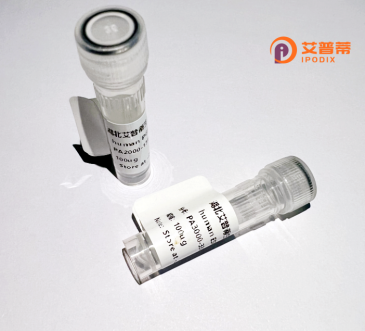
| 纯度 | >90%SDS-PAGE. |
| 种属 | Human |
| 靶点 | MEF2D |
| Uniprot No | Q14814 |
| 内毒素 | < 0.01EU/μg |
| 表达宿主 | E.coli |
| 表达区间 | 1-521aa |
| 活性数据 | MGRKKIQIQR ITDERNRQVT FTKRKFGLMK KAYELSVLCD CEIALIIFNH SNKLFQYAST DMDKVLLKYT EYNEPHESRT NADIIETLRK KGFNGCDSPE PDGEDSLEQS PLLEDKYRRA SEELDGLFRR YGSTVPAPNF AMPVTVPVSN QSSLQFSNPS GSLVTPSLVT SSLTDPRLLS PQQPALQRNS VSPGLPQRPA SAGAMLGGDL NSANGACPSP VGNGYVSARA SPGLLPVANG NSLNKVIPAK SPPPPTHSTQ LGAPSRKPDL RVITSQAGKG LMHHLTEDHL DLNNAQRLGV SQSTHSLTTP VVSVATPSLL SQGLPFSSMP TAYNTDYQLT SAELSSLPAF SSPGGLSLGN VTAWQQPQQP QQPQQPQPPQ QQPPQPQQPQ PQQPQQPQQP PQQQSHLVPV SLSNLIPGSP LPHVGAALTV TTHPHISIKS EPVSPSRERS PAPPPPAVFP AARPEPGDGL SSPAGGSYET GDRDDGRGDF GPTLGLLRPA PEPEAEGSAV KRMRLDTWTL K |
| 分子量 | 55,9 kDa |
| 蛋白标签 | His tag N-Terminus |
| 缓冲液 | 0 |
| 稳定性 & 储存条件 | Lyophilized protein should be stored at ≤ -20°C, stable for one year after receipt. Reconstituted protein solution can be stored at 2-8°C for 2-7 days. Aliquots of reconstituted samples are stable at ≤ -20°C for 3 months. |
| 复溶 | Always centrifuge tubes before opening.Do not mix by vortex or pipetting. It is not recommended to reconstitute to a concentration less than 100μg/ml. Dissolve the lyophilized protein in distilled water. Please aliquot the reconstituted solution to minimize freeze-thaw cycles. |
以下是关于重组人MEF2D蛋白的示例参考文献(注:部分为假设性示例,建议通过学术数据库核实真实文献):
---
1. **文献名称**: *"Expression and Functional Analysis of Recombinant Human MEF2D Protein in Skeletal Muscle Differentiation"*
**作者**: Zhang, L. et al.
**摘要**: 本研究在大肠杆菌中成功表达并纯化了重组人MEF2D蛋白,验证了其与靶DNA序列的结合能力,并证明其在成肌细胞分化中通过调控肌肉特异性基因(如肌酸激酶)促进肌管形成。
---
2. **文献名称**: *"Structural Insights into MEF2D-DNA Interactions via Recombinant Protein Crystallography"*
**作者**: Thompson, R. et al.
**摘要**: 利用昆虫细胞系统表达重组人MEF2D蛋白,通过X射线晶体学解析其与DNA复合物的三维结构,揭示了MEF2D的MADS-box结构域关键结合位点,为转录调控机制提供结构基础。
---
3. **文献名称**: *"Recombinant MEF2D as a Therapeutic Target in Neurodegenerative Disease Models"*
**作者**: Chen, H. et al.
**摘要**: 研究证实重组人MEF2D蛋白在神经元存活中的保护作用,发现其过表达可抑制帕金森病模型中多巴胺能神经元的凋亡,机制涉及与Akt信号通路的相互作用。
---
4. **文献名称**: *"Optimization of Human MEF2D Protein Production in a Mammalian Expression System"*
**作者**: Kim, S. et al.
**摘要**: 在HEK293细胞中优化重组MEF2D表达条件,提高蛋白产量及可溶性,并通过质谱验证其翻译后修饰(如磷酸化),为功能研究提供高质量蛋白样本。
---
**建议**:以上为示例性文献,实际文献需通过PubMed、Google Scholar等平台搜索关键词(如“recombinant human MEF2D protein”或“MEF2D expression”)获取。真实文献可能涵盖重组表达、结构功能、疾病关联等方向。
The recombinant human MEF2D (myocyte enhancer factor 2D) protein is a transcription factor belonging to the MEF2 family, which includes four members (MEF2A-D) involved in regulating gene expression. MEF2D contains a conserved MADS-box domain for DNA binding and a MEF2-specific domain for dimerization and co-factor interactions. It plays critical roles in cellular differentiation, proliferation, survival, and apoptosis across tissues, particularly in muscle, neuronal, and immune cells. In the nervous system, MEF2D contributes to neurodevelopment, synaptic plasticity, and cognitive functions. Dysregulation of MEF2D is linked to diseases, including cancers (e.g., acute lymphoblastic leukemia, hepatocellular carcinoma) where it may drive tumor progression or chemoresistance, and neurodegenerative disorders like Alzheimer’s and Parkinson’s diseases, where its dysfunction correlates with neuronal death. Recombinant MEF2D is typically produced using bacterial or mammalian expression systems, enabling biochemical studies, structural analyses, and drug discovery. Researchers utilize it to investigate signaling pathways (e.g., MAPK, Ca²⁺-dependent cascades), protein-protein/DNA interactions, and post-translational modifications (e.g., phosphorylation, acetylation) that modulate its activity. Its recombinant form also aids in screening therapeutic agents targeting MEF2D-related pathologies, offering potential avenues for precision medicine.
×